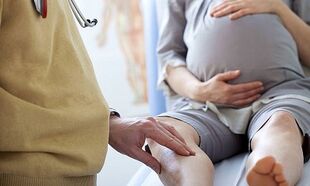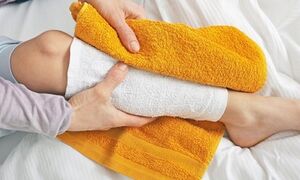Translated from the ancient Greek language, "varicose veins" means "swelling". Theoretically, a similar disease can occur anywhere on the body, but the most common lesion is the feet.
The essence of the problem
The veins in the body play a very important role, representing a network of branched reservoirs that carry blood from tissues to the heart muscle. In the lower extremities, this network is expressed in the form of deep and superficial veins, which are interconnected by an emergency system.
As a rule, the main focus is on the deep veins, so they are noticeably stronger and more voluminous. And on the surface, about 15% of the total work remains.
The heart is a "pump" that directs blood to the veins. Some of the blood flows through the veins against gravity (when you walk, move or end up). When the muscles relax (when standing), the blood flows down, under the influence of the same weight. But not everything is so simple, the valves on the walls of the vessels do not leave it behind.
In cases where the valves are "broken", the veins are dilated and inflamed, they can not maintain blood flow. This process contributes to the swelling and swelling of the veins. The impaired blood supply becomes the root from which the varicose veins in the legs start.
The causes of varicose veins
There are many reasons for this:
Varicose veins can be inherited, that is, there is a congenital weakness of the vessel walls. Varicose veins may be related to human activity and immunity.One thing is clear, the disease does not arise exactly like that, something must serve as a boost.
During sedentary work in the veins, or rather in the pelvis, stagnation of blood occurs, which then manifests itself in health problems. Varicose veins arise from a sedentary lifestyle, therefore, with permanent work there are no obstacles to its origin.
It is no coincidence that this disease, first of all, is called the occupational disease of salesmen and hairdressers.
The following are also obvious provocateurs:
- overweight (obesity),
- Frequent weight lifting
- foot injuries.
Another factor is increased intra-abdominal pressure. The size of the veins is constantly changing, inhalation - the veins are narrow, the exhalation, on the contrary, expands. When a person pushes hard, the veins are intensely stressed and under the pressure created they begin to expand.
Of course, this does not mean that everyone is at risk, but chronic constipation and coughing can cause varicose veins. Varicose veins during pregnancy
Very often varicose veins are found in pregnant women. The ever-expanding uterus exerts involuntary pressure on the veins of the legs. In this case, nature has protected women from serious consequences and has endowed the body, during pregnancy, with a sufficient amount of sex hormones, which make the walls of blood vessels plastic and flexible. As a rule, here the disease is reversible; after childbirth, the veins return to their previous state.
Prevention methods
Absolutely any disease is much easier to prevent than to cure, and varicose veins are no exception. Let's take a look at the main precautions:
- Forget tight and uncomfortable shoes. Women should remember that the "everyday" heel should not exceed five centimeters. In the evening, do your feet with a massage and a cool bath, then lower yourself and lie down in this position for 15 minutes.
- Wear loose clothing that does not have tight elastic bands or belts.
- If possible, walk barefoot on the pebbles as much as possible. At the very least, take care of these treatments while you are on vacation.
- Check your diet. Eliminate, or at least reduce, the consumption of spicy, salty and smoky foods. The same goes for alcohol.
- Sport is an excellent prevention of varicose veins. An exception may be the early stage of the disease. If you notice the first signs and symptoms in yourself, then the load should be weak and before you start training, be sure to consult your doctor.
- If you have sedentary work, try to get up as often as possible and walk around the room. Do basic exercises, at least jump a little. Do not cross your legs when sitting, this is very bad for blood circulation.
- Do not go to the sea with bathtubs, saunas and hot tubs. After the "hot" procedures, be sure to rinse with cold water.
Stages of varicose veins development
- First stage.No pain and discomfort, only cosmetic defects are observed. At the legs there is a branch drawing veins, "stars" and "grid" appear. At night, the legs swell a lot.
- Second stage.There is obvious swelling in the ankle area and severe heaviness in the legs. At night, cramps, numbness, pins and needles may occur.
- Third stage.Persistent severe swelling of the feet, seals form on the skin, spots appear on spots, itching and dermatitis.
- Fourth stage.Food ulcers appear on the skin of the feet.
What steps to take at the initial stage

Varicose veins of the lower extremities, if in the early stages, respond well to treatment, it is very likely that a competent "fight" will stop its development.
First, follow all the precautions described above. Review your wardrobe, if necessary, eliminate all "harmful" things, do the same with shoes. Give your feet a contrast shower, walk more barefoot and balance your meals.
Second, at the first symptoms, buy compression underwear, it can be tights or socks. The principle of their action is to distribute the pressure on the legs in such a way that the blood circulation is normalized and the symptoms are significantly reduced.
Regarding the consultation, it is necessary to visit not only a venologist, but also a gynecologist (for women) and an orthopedist. It is possible that hormonal contraceptives or flat feet may have caused circulatory problems.
Prevention of varicose veins during pregnancy
Almost every woman during pregnancy experiences problems with swelling of the legs and circulatory disorders. The enlarged uterus constantly presses on the inferior vena cava, interfering with its normal function.
But, as mentioned a little above, varicose veins in this case are reversible, the main thing is to take the necessary precautions in time.
- Buy comfortable orthopedic shoes so that your feet do not get tired when walking.
- Take daily walks. Do not sit or stand for long periods of time. To avoid venous stasis, place your feet on a hill during rest.
- Wear compression garments to prevent swelling.
- Light exercise that includes only the legs is a good help. The simplest foot movements in different directions are enough.
- Vitamin C is very good in preventing varicose veins. It has many beneficial properties that will give elasticity to the veins, while reducing the risk of many diseases.
Treatment of varicose veins
Complete cure of the disease is possible only surgically. Medications and exercise are used as adjunctive methods.
PhlevectomySurgeries can be either surgical in nature or using the latest technology. The former include phlebectomy, when varicose veins are removed.
Laser
In the second group there is laser coagulation, there are no incisions, heat radiation is applied to the problem area of the body.
Sclerotherapy
Another way to get rid of varicose veins is sclerotherapy. A special solution is injected into the damaged vein using a thin needle, which sticks to the walls of the vessels and then dissolves them.
But no matter what the doctors want, they are simply not able to eliminate the main cause of varicose veins - the weakness of the vessel walls. It is only in your power to prevent the disease through preventive measures.
Special exercises

Below we list a number of physical exercises that will not take much time, but the result will be great. You can make them at home.
- Exercise 1.Lie on the floor, raise your legs at a 90 ° angle to the floor and start moving your toes "from you to you". Repeat 10 times.
- Exercise 2.In the prone position, lift your legs and "draw" circles with your legs, 10 times in each direction.
- Exercise 3.The well-known "birch" has a good result. From a prone position, lift your legs and pelvis, resting the latter on your hands. Lock in this position for a few seconds. Repeat 4 times.
- Tip:Take some time to stretch. First, your body will always be flexible and, second, it will help shift blood from the veins.
- Exercise 4.Lie on the floor with your feet together, your knees pointing in opposite directions. Grab your legs and pull them towards you. Stay in this position for a while. Play the exercise 4 times.
- Exercise 5.Lie on your left side and rest on your elbow, with your right hand pulling your right foot. Do a few spring movements with the back of your hip (trying to reach your buttocks with your heel), stay for 10 seconds. Do the same for the left side.
Ointments
The purpose of drugs for the treatment of varicose veins is to provide elasticity and normalcy to the veins. The necessary medicine will be recommended by a specialist for complex treatment.
An anticoagulant cream can have a good prophylactic effect. The role of the latter is to anesthetize the affected areas, as well as to strengthen the blood vessels. Often, anti-wrinkle creams contain a number of vitamins: C, B5 and B1, thanks to which the regeneration period is significantly reduced.
Pills are also common in treatment, which:
- improve vascular tone.
- relieve inflammation.
- accelerates blood flow and lymph flow.
- elimination of microcirculatory disorders.
The tablets are divided into several groups: corticosteroids, phlebotonics, anticoagulants and non-steroidal analgesics.
Folk remedies

The conservative method of treatment is effective in the first stage of varicose veins, when a person feels heaviness in the legs and noticed a venous network in the skin. The faster corrective action is taken, the faster and more accurate the results will be. Here are some simple but effective recipes.
Garlic squeeze
Gruel is made from grated garlic and butter, in a ratio of 1: 2, which is then applied to the affected areas, securing with paper and bandage. Duration of exposure - night, in the morning rinse your foot with warm water.Chestnut
Chestnut tincture for internal use. Pour fifty grams of dry product with 500 ml of alcohol. The resulting product must be insisted for 14 days, filtered. Take three times daily before meals with water.
Kalanchoe Ointment
A liter jar should be half filled with leaves and the rest filled with 70% alcohol. The resulting tincture should be placed in a dark place for two weeks, but shake daily. The final ointment is rubbed daily on the damaged areas.
Love yourself and become healthy!




































